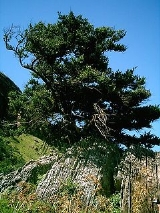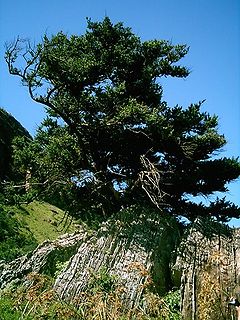
Wildlife of Cameroon
Encyclopedia

Cameroon
Cameroon, officially the Republic of Cameroon , is a country in west Central Africa. It is bordered by Nigeria to the west; Chad to the northeast; the Central African Republic to the east; and Equatorial Guinea, Gabon, and the Republic of the Congo to the south. Cameroon's coastline lies on the...
is composed of its flora
Flora
Flora is the plant life occurring in a particular region or time, generally the naturally occurring or indigenous—native plant life. The corresponding term for animals is fauna.-Etymology:...
and fauna
Fauna
Fauna or faunæ is all of the animal life of any particular region or time. The corresponding term for plants is flora.Zoologists and paleontologists use fauna to refer to a typical collection of animals found in a specific time or place, e.g. the "Sonoran Desert fauna" or the "Burgess shale fauna"...
.
The Cameroonian Highlands forests
Cameroonian Highlands forests
The Cameroonian Highlands forests are a montane tropical moist broadleaf forest ecoregion located on the range of mountains that runs inland from the Gulf of Guinea and forms the border between Cameroon and Nigeria...
extend across the Cameroon Highlands, covering an area of 38000 square kilometres (14,671.9 sq mi) in eastern Nigeria and western Cameroon. The ecoregion
Ecoregion
An ecoregion , sometimes called a bioregion, is an ecologically and geographically defined area that is smaller than an ecozone and larger than an ecosystem. Ecoregions cover relatively large areas of land or water, and contain characteristic, geographically distinct assemblages of natural...
lies above 900 meters elevation, and is surrounded at lower elevations by the Cross-Sanaga-Bioko coastal forests
Cross-Sanaga-Bioko coastal forests
The Cross-Sanaga-Bioko coastal forests are a tropical moist broadleaf forest ecoregion of west-central Africa. This is lush forest rich in flora and birdlife.-Location and description:...
at the southern end of the range, and by forest-savanna mosaic
Forest-savanna mosaic
Forest-savanna mosaic is an transitory ecotone between the tropical moist broadleaf forests of Equatorial Africa and the drier savannas and open woodlands to the north and south of the forest belt...
along the central and northern ends of the range; the Cameroon Highlands form the boundary between the Guinean
Guinean forest-savanna mosaic
The Guinean forest-savanna mosaic is an ecoregion of West Africa, a band of interlaced forest, savanna, and grassland running east to west and dividing the tropical moist forests near the coast from the West Sudanian savanna of the interior.-Setting:...
and Northern Congolian forest-savanna mosaic
Northern Congolian forest-savanna mosaic
The Northern Congolian forest-savanna mosaic is a forest and savanna ecoregion of central Africa, part of the belt of transitional forest-savanna mosaic that lie between Africa's equatorial forests and the tropical dry forests, savannas, and grasslands that lie to the north and south...
ecoregions.
Flora
The vegetation varies with elevation. Submontane forests extend from 900 to 1800 meters (3000 to 6000 ft) elevation. Above 1800 meters (6000 ft) elevation are distinct montane forests and patches of montane grassland, bamboo forest, and subalpine grasslands and shrublands. The ecoregion is characterized by the presence of afromontaneAfromontane
Afromontane is a term used to describe the Afrotropic subregion and its plant and animal species common to the mountains of Africa and the southern Arabian Peninsula...
species, which have an archipelago-like distribution across the highlands of Africa. Typical afromontane species are Nuxia congesta, Podocarpus latifolius
Podocarpus latifolius
Podocarpus latifolius is a large evergreen tree up to 35 m high and 3 m trunk diameter, in the conifer family Podocarpaceae; it is the type species of the genus Podocarpus....
, Prunus africana
Prunus africana
Prunus africana, or Red Stinkwood , is an evergreen tree native to the montane regions of Sub-Saharan Africa and the Islands of Madagascar, Sao Tome, Fernando Po and Grande Comore at about 900–3400 m. of altitude. The mature tree is 10–25 m. high, open-branched and often pendulous in forest,...
, Rapanea melanophloeos
Rapanea melanophloeos
Rapanea melanophloeos, commonly known as Cape Beech, Kaapse Boekenhout or IsiCalabi, is native to the afromontane forests of Southern Africa.-Distribution:...
, and Syzygium guineense bamendae.
Birds

Endemic (ecology)
Endemism is the ecological state of being unique to a defined geographic location, such as an island, nation or other defined zone, or habitat type; organisms that are indigenous to a place are not endemic to it if they are also found elsewhere. For example, all species of lemur are endemic to the...
species, along with several more that are also found in the nearby Mount Cameroon and Bioko montane forests
Mount Cameroon and Bioko montane forests
The Mount Cameroon and Bioko montane forests ecoregion, of the tropical and subtropical moist broadleaf forests Biome, are in Afromontane habitats in Cameroon and Equatorial Guinea of Africa.- Setting :...
ecoregion.
Seven species of birds Maegan Schrieter are strictly endemic: the Bamenda apalis (Apalis bamendae), Bangwa forest warbler (Bradypterus bangwaensis), white-throated mountain-babbler (Kupeornis gilberti), banded wattle-eye (Platysteira laticincta), Bannerman's weaver (Ploceus bannermani), Bannerman's turaco (Tauraco bannermani), and Mt. Kupe bushshrike (Telophorus kupeensis). Fourteen species are endemic to the Cameroon Highlands forests and Mt. Cameroon: Andropadus montanus, Phyllastrephus poliocephalus, Laniarius atroflavus, Malaconotus gladiator, Cossypha isabellae and the subspecies Cisticola chubbi discolor (sometimes considered a separate species C. discolor). Nine more montane endemic species are shared with Mt. Cameroon and Bioko: Psalidoprocne fuliginosa, Andropadus tephrolaemus, Phyllastrephus poensis, Phylloscopus herberti, Urolais epichlora, Poliolais lopezi, Nectarinia oritis, Nectarinia ursulae, and Nesocharis shelleyi.
Eleven small mammal species are endemic to the ecoregion: Eisentraut's striped mouse (Hybomys eisentrauti), the African wood mouse Hylomyscus grandis, Mount Oku mouse (Lamottemys okuensis), Mittendorf's striped grass mouse (Lemniscomys mittendorfi), two brush-furred mouse species (Lophuromys dieterleni and L. eisentrauti), Oku mouse shrew (Myosorex okuensis), Rumpi mouse shrew (M. rumpii), western vlei rat (Otomys occidentalis), Hartwig's soft-furred mouse (Praomys hartwigi), and Isabella's shrew (Sylvisorex isabellae).
Endangered species
The ecoregion is home to several endangered primatePrimate
A primate is a mammal of the order Primates , which contains prosimians and simians. Primates arose from ancestors that lived in the trees of tropical forests; many primate characteristics represent adaptations to life in this challenging three-dimensional environment...
s, including the Cross River Gorilla
Cross River Gorilla
The Cross River gorilla is a subspecies of the western gorilla that can be found on the border between Nigeria and Cameroon, in both tropical and subtropical moist broadleaf forests which are also home to the Nigeria-Cameroon Chimpanzee, another subspecies of great ape...
(Gorilla gorilla diehli), an endemic subspecies of Western Gorilla
Western Gorilla
The western gorilla is a great ape and the most populous species of the genus Gorilla.-Taxonomy:Nearly all of the individuals of this taxon belong to the western lowland gorilla subspecies whose population is approximately 95,000 individuals...
, Mainland Drill
Mainland Drill
The mainland drill is a subspecies of the endangered drill. It is distinguished by ringed yellow and black coloring on its crown, and is otherwise similar to the Bioko drill....
(Mandrillus leucophaeus leucophaeus), Preuss's Red Colobus
Preuss's Red Colobus
Preuss's red colobus is a red colobus primate species endemic to the Cross-Sanaga Rivers ecoregion. An important population occurs in Korup National Park, Southwest Province, Cameroon, but the species' distribution is localized...
(Pilocolobus preussi), and Common Chimpanzee
Common Chimpanzee
The common chimpanzee , also known as the robust chimpanzee, is a great ape. Colloquially, the common chimpanzee is often called the chimpanzee , though technically this term refers to both species in the genus Pan: the common chimpanzee and the closely related bonobo, formerly called the pygmy...
(Pan troglodytes).
Nine species of reptiles and 40 species of amphibians are endemic to the ecoregion

